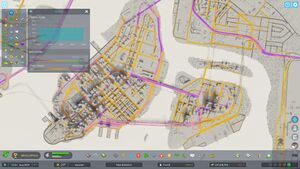| 第5行: | 第5行: | ||
In Cities: Skylines II agents choose a route based on a pathfinding cost. This cost is calculated using multiple factors such as the city’s road network, traveling time, travel cost, agent preferences, and more which we will cover in more detail below. Furthermore, agents will adjust their route based on events along the way. They may change lanes to avoid a car accident or a stopped service vehicle or make room for a vehicle responding to an emergency. | In Cities: Skylines II agents choose a route based on a pathfinding cost. This cost is calculated using multiple factors such as the city’s road network, traveling time, travel cost, agent preferences, and more which we will cover in more detail below. Furthermore, agents will adjust their route based on events along the way. They may change lanes to avoid a car accident or a stopped service vehicle or make room for a vehicle responding to an emergency. | ||
== | == 寻路成本 == | ||
{{SVersion|pre-release}} | {{SVersion|pre-release}} | ||
寻路运算基于四个主要因素:时间、舒适度、金钱和行为模式。 | |||
''' | ''' 时间''' 是计算路径的重要因素。其他因素也会影响路径选择,但时间通常是重中之重,毕竟所有寻路单位都希望尽快抵达目的地。如果只考虑行程所需时间,虽然小路的长度可能短于公路,公路上的行驶速度却高于小路,因而所需时间也更短。因此大多数情况下,如果公路总体耗时更短,寻路单位都会选择公路。 | ||
''' | ''' 舒适性''' 是寻路的重要因素,包括将旅程规划得尽可能顺畅,避免在十字路口进行多余的转弯,以及找到合适的停车地点或下车的公共交通车站。舒适度直接计入寻路成本,其中每一项都会计入总成本。 | ||
''' | ''' 金钱''' 在寻路成本中体现为燃料消耗和潜在停车费用。市民会权衡交通和停车费用,将其与其他出行方式乃至步行比较,选取更快捷、舒适、实惠的方案。对于送货车辆而言,送货距离越长,运送资源的成本就越高。因此,相较送往外部连接,就近销售资源和产品的运输成本更低,公司成本效益更高。 | ||
''' | ''' 行为模式''' 是指寻路单位在移动过程中做出“危险 ” 决定(例如掉头)的意愿。市民和送货车辆不太会为减少寻路成本而做出危险决定,但应急车辆的行为模式更宽松,这样它们在紧急情况下不至于被堵在路上,必要时可以做出危险的寻路决定。 | ||
服务车辆基于最低寻路总成本派遣。需要调派服务车辆时,算法会考虑所有可调派车辆在当下和未来一小段时间内离目的地的距离(比如车辆在完成上一项任务后会位于何处)。举个例子,需要一辆道路养护车辆来维修某路段。算法会确认所有可用车辆目前的位置,以及它们为了完成当前任务需要去什么位置。如果车辆A在完成当前任务后即将抵达路段附近地点,那么算法也许会将任务分派给车辆A,而非当下就在附近的车辆B。 | |||
距离增加会导致成本增加,因而资源运输会受到路线长度影响。公司会尽可能选择更近的收货地点,以增加利润。将资源和商品运出城市成本高昂,会大大降低公司的盈利能力。 | |||
== Traffic accidents == | == Traffic accidents == | ||
2023年11月12日 (日) 14:18的版本
Cities: Skylines II individually tracks the passage of every vehicle through your city's road system. These include service vehicles, citizens' private transportation, and freight. It is important to manage the flow of traffic on your roads, as a blocked road causes delays in services reaching certain areas, and an increase in noise pollution.
In Cities: Skylines II agents choose a route based on a pathfinding cost. This cost is calculated using multiple factors such as the city’s road network, traveling time, travel cost, agent preferences, and more which we will cover in more detail below. Furthermore, agents will adjust their route based on events along the way. They may change lanes to avoid a car accident or a stopped service vehicle or make room for a vehicle responding to an emergency.
寻路成本
寻路运算基于四个主要因素:时间、舒适度、金钱和行为模式。
时间是计算路径的重要因素。其他因素也会影响路径选择,但时间通常是重中之重,毕竟所有寻路单位都希望尽快抵达目的地。如果只考虑行程所需时间,虽然小路的长度可能短于公路,公路上的行驶速度却高于小路,因而所需时间也更短。因此大多数情况下,如果公路总体耗时更短,寻路单位都会选择公路。
舒适性是寻路的重要因素,包括将旅程规划得尽可能顺畅,避免在十字路口进行多余的转弯,以及找到合适的停车地点或下车的公共交通车站。舒适度直接计入寻路成本,其中每一项都会计入总成本。
金钱在寻路成本中体现为燃料消耗和潜在停车费用。市民会权衡交通和停车费用,将其与其他出行方式乃至步行比较,选取更快捷、舒适、实惠的方案。对于送货车辆而言,送货距离越长,运送资源的成本就越高。因此,相较送往外部连接,就近销售资源和产品的运输成本更低,公司成本效益更高。
行为模式是指寻路单位在移动过程中做出“危险”决定(例如掉头)的意愿。市民和送货车辆不太会为减少寻路成本而做出危险决定,但应急车辆的行为模式更宽松,这样它们在紧急情况下不至于被堵在路上,必要时可以做出危险的寻路决定。
服务车辆基于最低寻路总成本派遣。需要调派服务车辆时,算法会考虑所有可调派车辆在当下和未来一小段时间内离目的地的距离(比如车辆在完成上一项任务后会位于何处)。举个例子,需要一辆道路养护车辆来维修某路段。算法会确认所有可用车辆目前的位置,以及它们为了完成当前任务需要去什么位置。如果车辆A在完成当前任务后即将抵达路段附近地点,那么算法也许会将任务分派给车辆A,而非当下就在附近的车辆B。
距离增加会导致成本增加,因而资源运输会受到路线长度影响。公司会尽可能选择更近的收货地点,以增加利润。将资源和商品运出城市成本高昂,会大大降低公司的盈利能力。
Traffic accidents
Cities: Skylines II features traffic accidents where vehicles lose control and crash into traffic or buildings. The likelihood of an accident happening is calculated per road segment and is increased by features such as road conditions, lighting conditions, weather, and disasters. Keeping roads in good condition by using road maintenance services and having streetlights is a good way to decrease accident probability on the road.
When an accident takes place, a vehicle on the segment will lose control and be pushed in a random direction. Collision physics allow it to hit any obstacle on the way, and if a vehicle collides with another vehicle it may start a chain reaction.
Accident sites need to be secured and cleared by the police and road maintenance, respectively. Traffic will be blocked on the lanes that are affected by the accident, potentially blocking the road if all lanes are blocked. Ambulances might also be called to the site if the accident was severe enough to cause serious injuries. If clearing the site of the accident causes traffic jams for a prolonged period, agents might recalculate their pathfinding and make U-turns to find alternative routes circumventing the blocked lane.
Intercity traffic
Cities: Skylines II also features traffic between other cities, from one outside connection to the next. This traffic does not contribute to the city’s economy but the traffic can become part of the overall traffic flow as the city grows and the highways are integrated into the city’s road network. If the player builds a shorter route between two outside connections, the traffic between those cities will change to use the newly created option if it is more cost-efficient in regard to pathfinding.
Finding traffic
Roads with heavy and/or congested traffic can be observed visually, simply by looking at the flow of vehicles on the roads. Long tailbacks will be fairly obvious. Watching the flow (or lack thereof) of traffic at a junction or intersection can provide clues as to the cause, and solution, of a given traffic flow problem.
Additionally, Cities: Skylines II has a traffic info view. Clicking it overlays a gradient of green to red on the roads, depending on how well the traffic flows. A second view can be enabled by selecting "Traffic Volume" in the map legend. Details about a road can be obtained by clicking on the name of the road.


